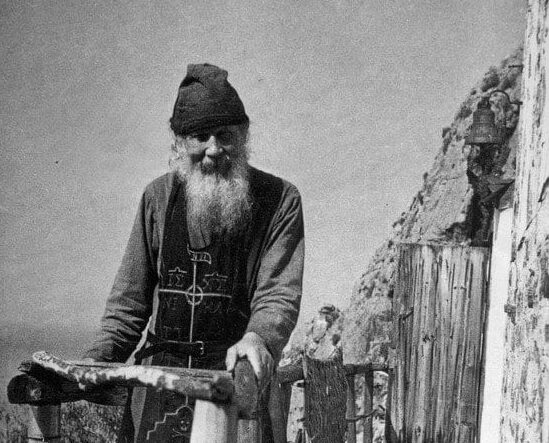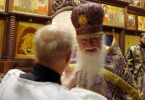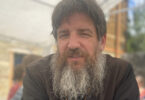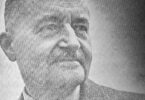The following is not a biography in the full sense of the term, but a personal recollection which imparts the spiritual fragrance that permeated the life of this grace-filled elder.
In the summer of 1926, during my second pilgrimage to Athos, I spent four unforgettable days with the great Elder, Schema-hieromonk[1] a priestmonk who has been tonsured into the Great Schema Theodosy, in that most austere Athonite wilderness, Karoulia. The life of this Elder is extremely remarkable, but as it is not possible for me to give his full biography, I shall tell what has been preserved in my memory from the stories told about him on Athos in that wonderful time of the twenties.
Eather Theodosy came from a religious family. He graduated from one of the seminaries in the region of the Volga, and later from the Kazan Theological Academy. As a government scholarship student, he was then obliged to serve for an appointed number of years as a seminary teacher. Where he became a monk, I do not recall. I know that after serving for several years as a hieromonk, he was awarded a gold pectoral cross. He was also an inspector of the seminary for some time. When it was about time for his obligatory service to come to an end, he was offered the rectorship of a seminary with the rank of archimandrite. In a short time he would have become a hierarch, but this Eather Theodosy decisively refused. He was drawn by the desert and its inner spiritual activity. In the 1880’s, as soon as his obligatory service had ended, he handed in his resignation and went off to Athos.
On Athos he found himself in a rather difficult position. No Russian monastic community wanted to receive into the number of its brethren a learned hieromonk, and one with a gold pectoral cross at that! On Athos in those days they were opposed to accepting even simple monks from outside, and if they did, they would place them on a lower standing than the most junior monk of their own community. And here was not only an educated monk, but one with a gold cross! According to his rank, he should have been made senior to the tried local hieromonks who had labored on Athos for 25 or 30 years.
In a word, there was no place for the newcomer, either in the monasteries or in the sketes. Fr. Theodosy then turned to the kelliots and solitaries who lived in twos and threes in small cells scattered over the Holy Mountain. On Athos there were more than a hundred of these.[2] Russian communities alone But the kelliots were also reluctant to accept such an educated and experienced monk.
Finally, one hermit, an iconographer, agreed to accept Father Theodosy in the capacity of a simple novice. The latter humbly consented and became the Elder’s obedient servant. He cooked food for him, collected firewood and tidied up their dwelling. The Elder, by testing him severely, humbled him. In the presence of visitors, people who had come to buy icons, he would often shout at him: “Hey, you learned fool, put on the samovar for the guests,” and the like.
Thus passed several years. By his great humility and patience, Father Theodosy acquired the right to become an Athonite. However, he desired greater solitude and an even stricter ascetic life. Hugging a cliff high above the sea at the tip of Athos lies the area of Karoulia, noted for its severe lifestyle.
There, living for the most part in caves, were some twenty exceptionally strict ascetics. They each lived separately, assembling only on Sundays and the Great Feasts for the divine services in a tiny church. The hermits had no abbot, but they had a spiritual father, an elder who lived near the church.
The Karoulian ascetics fasted strictly. During all the fasts they ate only bread and water on weekdays; on Saturdays and Sundays they would prepare hot foot, but without oil. They ate fish only on the Great Feasts, and only on Pascha did they eat a small colored egg and a piece of sheep’s cheese. Their food supplies, furnished by St. Panteleimon’s Monastery, rarely arrived more than twice a month. To receive these supplies, the hermits let down a basket on a long rope over the rocks.
Moving about that part of Athos was difficult and dangerous. The paths were narrow, often no more than two feet wide, with an abyss of several hundred feet below. For safety’s sake ropes were stretched along the narrowest paths, especially in the slippery winter season. In this century the ropes were replaced by iron chains donated by a certain benefactor. I walked along these paths in 1926. It was frightening to look down; one’s breath was taken away at the sight of the void beneath.
It was in this desert place that Father Theodosy also lived, waiting in turn for the death of one of the inhabitants so that he could take possession of his cave. There also he received the Great Schema, with the name Theodosy, having already been a monk of the small schema for over twenty years.
After the death of Karoulia’s elder, the hermits chose Father Theodosy to replace him as their spiritual father. Gradually other Athonite monks, and even abbots of the Russian monastic houses began to seek out his aid. (Before the First World War there were over a hundred monastic communities, large and small, on Athos. The number of Russian monks there at that time reached ten thousand.)
Many began to correspond with Father Theodosy, seeking his counsel, and he made all possible efforts to answer them, imitating the renowned Russian recluse of the 19th century, Bishop Theophan of Vysha [with whom he had an active correspondence].
Father Theodosy led a very strict manner of life. He used to sleep no more than two or three hours a day, and oftentimes — even on feastdays — he ate nothing at all.
In the I920’s the Patriarchates of Constantinople and Alexandria brought over their patriarchates to the new-style calendar. All Athos, with the exception of the monastery of Vatopedi, decisively rose up to oppose this illicit innovation. The Athonite fathers, including the Greeks, requested Father Theodosius to compose a well-grounded refutation of the innovation, which he did. Later this booklet was reprinted at Vladimirova in the Carpathian Mountains, and not so long ago it was republished by Holy Trinity Monastery [Jordanville, N.Y.].
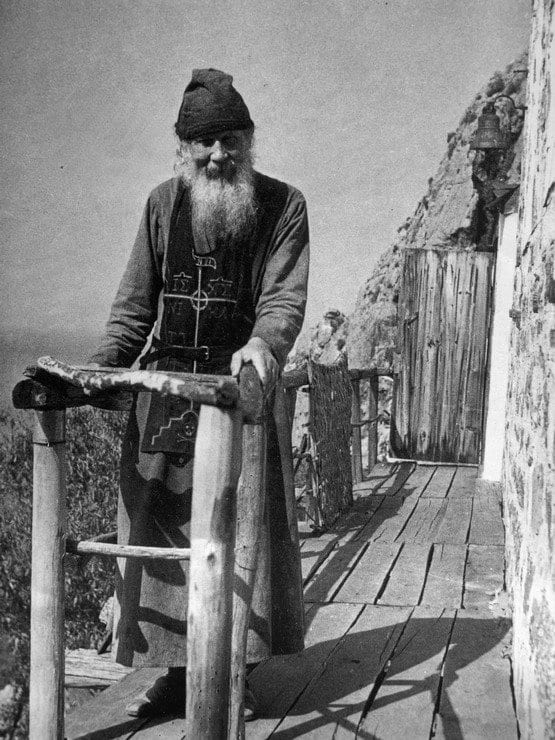 Now I shall recount my personal meeting with Father Theodosy. I originally heard of him during my first pilgrimage to Athos at Pascha, 1923, but I did not manage to see him then because our pilgrimage of students from the Belgrade department of theology lasted only ten days, and this was too short a time to cover all of Athos.
Now I shall recount my personal meeting with Father Theodosy. I originally heard of him during my first pilgrimage to Athos at Pascha, 1923, but I did not manage to see him then because our pilgrimage of students from the Belgrade department of theology lasted only ten days, and this was too short a time to cover all of Athos.
In 1924, the famous writer of maritime stories, V.P. Aprelev, a captain of the second rank, made a prolonged visit to Athos. He gave a talk in Belgrade concerning his pilgrimage, his visit to Karoulia and Father Theodosy. He said that the elders there were in extreme need of clothing and simply wore rags. Several of us, students, were eager to help them. We made a collection and I was entrusted with sending the money to Father Theodosy with a letter explaining that the donors wished this money to be used exclusively for buying warm clothing for the Karoulian ascetics. Father Theodosy wrote me a letter of thanks, and a correspondence ensued. (To my distress, l lost all his letters during the evacuation from Vladimirova in 1944-45.)
In those years, after completing university, I began seriously to think about entering the monastic life; it was my wish to he tonsured by Father Theodosy. In 1925 I began teaching catechism in Skopje, in Yugoslavia. The following summer, after finishing teaching in the secondary school, I went to Athos and, with a monk as a guide, I set out for Karoulia.
We arrived two days before the feast of Sts. Peter and Paul. Holding onto the chains we climbed up to Father Theodosy’s cell. Not long before the First World War, a benefactor had built a small chapel for him on the ledge of the cliff, with a capacity of not more than twenty pilgrims. Near it was a cell for the Elder. Father Theodosy had a guesthouse for those who came to see him: three small caves into which one was able to enter only by bending very low. In each there was a wooden bed, and nothing else.
On reaching his cell we found it open, but there was no one in it, nor in the chapel. We sat down and waited. Within an hour or two the Elder appeared in an old cassock, with a small bunch of dry twigs that he had gathered on the steep slope of the mountain. My guide left, and the two of us remained. Father Theodosy “treated” me to some dry bread and a mug of water; the Apostles’ Fast had not yet ended.
I told the Elder of my desire to receive the tonsure from him. He smiled and answered that he would not tonsure anyone who was going to leave, but that if I wanted to be tonsured by him I would have to promise to remain forever on Karoulia. I was not prepared for this and asked for time to think and pray. Thus, I lived with the Elder for four unforgettable days, cooped up in a tiny cave, the “guesthouse”. The greater part of the night we spent in prayer in the church. I remember the All-night Vigil for the feast. It lasted literally all night, from sunset to sunrise. I stood mostly on the small wrought- iron balcony with a chasm of perhaps a thousand feet under me and a marvelous view of the calm sea illumined by the brilliance of the moon and stars.
On the morning of the feast itself, after confession with Father Theodosy, I partook of the Holy Mysteries. The next day Father Theodosy said to me: “Let’s do this. I’ll send you to my spiritual father, Ignaty. He is 105 years old and blind, but a real clairvoyant elder. I’ll never come anywhere near his state. Tell him all about yourself and, as he decides, so you ought to act. Would you agree to remain in Karoulia if he blesses you for this?” I had taken such a liking to Karoulia that I answered in the affirmative.
Father Theodosy gave me a guide from among the hermits of Karoulia, the schema-monk Dorotheus, and together we began to climb the steep mountainous slopes to Schema-hieromonk Ignaty’s. He lived about two miles above Karoulia, on the most gentle slope of the mountain. He had a 90 year-old Greek cell-attendant who, upon learning that I had come from Father Theodosy, silently pointed out to me a separate little cell where the Elder lived. I went in. The main corner was covered with icons. Beneath the icons on a narrow wooden bed sat the comely, blind Elder, fingering a prayer-rope. I made a prostration before him and said that Father Theodosy had sent me. I took his blessing. Then Father Ignaty put on his epitrachelion [priestly stole] and gave the blessing for beginning the order of confession. I recited the small doxology and through to the Lord’s Prayer, and… stopped because at that time, to my shame, I didn’t know the 50th psalm.
The Elder said: “Say ‘Have mercy on me,
O God … ‘
I answered that I did not know it by heart.
“How is it that you don’t know it? You’re a monk and you don’t know it?!”
“I am not a monk,” I replied, “but a pilgrim visiting from Serbia.”
“And I tell you that you are a monk,” he retorted.
Then he pointed to a piece of cardboard hanging on the wall, on which was written the whole order of the rite of confession. I read it. Afterwards the Elder made me kneel before the icons near him, and he covered me with his epitrachelion and said: “First confess all your sins and then say what it is you want from me.”
My confession covered virtually my whole life. I then told the Elder that I was a teacher of catechism in a secondary school in the city of Skopje, that I wanted to become a monk and would like to have Father Theodosy tonsure me, but that he had given as a condition of tonsure that I stay with him forever in Karoulia, and that he had sent me to him to decide my fate. “As you say, so shall I do,” I added.
I spoke, of course, in more detail. The Elder patiently heard me out, and said: “Let us pray to God!”
For some time we prayed silently, during which time the Elder held his hands on my head. Then he performed the absolution of sins; with his blessing right hand he made the sign of the cross on my head, quite hard, almost hitting it. And he said: “Go back to where you came from; you are needed there, Pray to Great-martyr Panteleimon. You will find an Elder in another country.
With these parting words from the great Elder, I returned to Father Theodosy accompanied by Father Dorotheus who had waited for me at the cell-attendant’s.
After listening to me attentively, Father Theodosy explained the Elder’s words: the fact that he twice insistently called me a monk showed that he blessed my intention to be tonsured; the counsel to return to Yugoslavia and to pray to the Holy Great-martyr Panteleimon signified that he ought not to tonsure me himself but that I would be tonsured in St. Panteleimon’s Monastery; that I would find an elder in another country indicated that I would not long remain in Yugoslavia, but that I would go off to work in some other country…
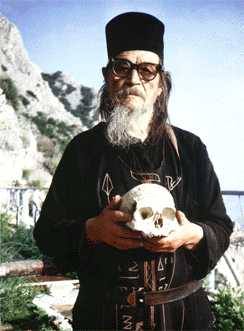
Fr. Nikodim of Karula with the skull of his abba Theodosios
Everything came to pass as the Elders had foretold: I was tonsured in St. Panteleimon’s Monastery, I remained in Skopje for another two years and then went to Carpatho-Russia to Vladimirova, to Archimandrite (later Archbishop) Vitaly[3] first abbot of Holy Trinity Monastery, Jordanville, NY (+May 8/21, 1960) in whom I also found myself an elder.
I used to remember several accounts of his clairvoyance which I had heard on Athos, but, unfortunately, I have forgotten them. There remains in my memory only that which affected me personally, and this I have written.
Grant rest, O Lord, to the soul of Thy righteous and ever-memorable servant, Schema-hieromonk Theodosius, one of the last clairvoyants of our afflicted times.
(From a translation that appeared in “The Shepherd,” July, 1986; Saint Edward Brotherhood, England; Russian original published in Vera i Zhizn, No. 8, 1974. Photos are kindly shared by Sergei Shumilo Director of The International Institute of the Athonite Legacy in Ukraine and Editor in Chief of The Athonite Heritage)

